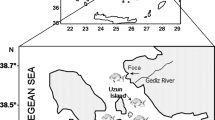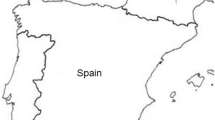Abstract
Organochlorine pesticides (OCPs), such as HCHs and DDTs, are still used as pesticides in the Southern Hemisphere and can reach the North Pacific due to long range atmospheric transfer. Marine mammals (Pacific walrus Odobenus rosmarus divergens, gray whale Eschrichtius robustus), the seabirds (Pacific gull Larus schistisagus, crested auklet Aethia cristatella, auklet crumb Aethia pusilla, northern fulmar Fulmarus glacialis, and grey petrel Oceanodroma furcata) and Pacific salmon (pink Oncorhynchus gorbuscha, chum O. keta, chinook O. tshawytscha, and sockeye O. nerka) were collected near the Kuril Islands (the northern–western part of the Pacific Ocean), in the Sea of Okhotsk and the Bering Sea. The total OCPs concentration (HCHs + DDTs) was found in each organism, including the Pacific walrus (70–90,263 ng/g lipid), the seabirds (29–16,095 ng/g lipid), and the Pacific salmon (41–7103 ng/g lipid). The concentrations and possible sources of OCPs in marine organisms as biological indicators are discussed.



Similar content being viewed by others
References
Bidleman TF (1999) Atmospheric transport and air-surface exchange of pesticides. Water Air Soil Pollut 115:115–166. doi:10.1023/A:1005249305515
Burdin A, Filatova OA, Hoyt E (2009) Marine mammals of Russia. Kirov regional press, Kirov
Fellin P, Dougherty D, Barrie LA et al (1996) Air monitoring in the arctic: results for selected persistent organic pollutants for 1992. Environ Toxicol Chem 15:253–261. doi:10.1002/etc.5620150305
Halsall CJ, Bailey R, Stern GA et al (1998) Multi-year observations of organohalogen pesticides in the Arctic atmosphere. Environ Pollut 102:51–62. doi:10.1016/S0269-7491(98)00074-8
Holt EA, Miller SW (2010) Bioindicators: using organisms to measure environmental impacts. Nat Educ Knowl 3(10):8
Isobe T, Ochi Y, Ramu K et al (2009) Organohalogen contaminants in striped dolphins (Stenella coeruleoalba) from Japan: present contamination status, body distribution and temporal trends (1978–2003). Mar Pollut Bull 58:396–401. doi:10.1016/j.marpolbul.2008.10.008
Iwata H, Tanabe S, Sakai N, Tatsukawa R (1993) Distribution of persistent organochlorines in the oceanic air and surface seawater and the role of ocean on their global transport and fate. Environ Sci Technol 27:1080–1098. doi:10.1021/es00043a007
Kunisue T, Watanabe M, Subramanian A et al (2003) Accumulation features of persistent organochlorines in resident and migratory birds from Asia. Environ Pollut 125:157–172. doi:10.1016/S0269-7491(03)00074-5
Li A, Tanabe S, Jiang G et al (2007) Persistent organic pollutants in Asia sources, distributions, transport and fate. Elsevier, Amsterdam
Lukyanova O (2013) Persistent organic pollutants in marine ecosystems in Russian Far East: sources, transport, biological effects. LAP LAMBERT Academic Publishing, Saarbrücken
Lukyanova ON, Tsygankov VY, Boyarova MD, Khristoforova NK (2014) Pesticide biotransport by Pacific salmon in the northwestern Pacific Ocean. Dokl Biol Sci 456:188–190. doi:10.1134/S0012496614030089
Lukyanova ON, Tsygankov VY, Boyarova MD, Khristoforova NK (2015) Pacific salmon as a vector in the transfer of persistent organic pollutants in the Ocean. J Ichthyol 55:425–429. doi:10.1134/S0032945215030078
Lukyanova ON, Tsygankov VY, Boyarova MD, Khristoforova NK (2016) Bioaccumulation of HCHs and DDTs in organs of Pacific salmon (genus Oncorhynchus) from the Sea of Okhotsk and the Bering Sea. Chemosphere 157:174–180. doi:10.1016/j.chemosphere.2016.05.039
Oehme M, Haugen J-E, Schlabach M (1996) Seasonal changes and relations between levels of organochlorines in arctic ambient air: first results of an all-year-round monitoring program at Ny-Ålesund, Svalbard, Norway. Environ Sci Technol 30:2294–2304. doi:10.1021/es950701+
Rolland R, Gilbertson M, Colborn T (1995) Environmentally induced alterations in development: a focus on wildlife. Environ Health Perspect 103:3–5
Shuntov VP (1998) The birds of far eastern seas of Russia. TINRO-Center, Vladivostok
Tanabe S, Subramanian A (2006) Bioindicators of POPs: monitoring in developing countries. Kyoto University Press, Kyoto and Trans Pacific Press, Melbourne
Tanabe S, Iwata H, Tatsukawa R (1994) Global contamination by persistent organochlorines and their ecotoxicological impact on marine mammals. Sci Total Environ 154:163–177. doi:10.1016/0048-9697(94)90086-8
Trukhin AM, Boyarova MD (2013) Chlorinated pesticides in tissues and organs of spotted seals (Phoca largha Pallas, 1811) from the Sea of Japan. Contemp Probl Ecol 6:336–342. doi:10.1134/S199542551303013X
Tsydenova OV, Batoev VB, Weissflog L, Wenzel K-D (2003) Pollution of Lake Baikal Basin: organochlorine pesticides. Chem Sustain Dev 11:349–352 (in Russian)
Tsygankov VY, Boyarova MD (2015) Sample preparation method for the determination of organochlorine pesticides in aquatic organisms by gas chromatography. Achieve Life Sci 9:65–68. doi:10.1016/j.als.2015.05.010
Tsygankov VY, Boyarova MD, Lukyanova ON (2014) Persistent toxic substances in the muscles and liver of the pacific walrus Odobenus rosmarus divergens Illiger, 1815 from the Bering Sea. Russ J Mar Biol 40:147–151. doi:10.1134/S1063074014020102
Tsygankov VY, Boyarova MD, Kiku PF, Yarygina MV (2015a) Hexachlorocyclohexane (HCH) in human blood in the south of the Russian Far East. Environ Sci Pollut Res 22:14379–14382. doi:10.1007/s11356-015-4951-3
Tsygankov VY, Boyarova MD, Lukyanova ON (2015b) Bioaccumulation of persistent organochlorine pesticides (OCPs) by gray whale and Pacific walrus from the western part of the Bering Sea. Mar Pollut Bull 99:235–239. doi:10.1016/j.marpolbul.2015.07.020
Tsygankov VY, Boyarova MD, Lukyanova ON (2016) Bioaccumulation of organochlorine pesticides (OCPs) in the northern fulmar (Fulmarus glacialis) from the Sea of Okhotsk. Mar Pollut Bull 110:82–85. doi:10.1016/j.marpolbul.2016.06.084
UNEP (United Nations Environmental Program) (2005) Ridding the world of POPs: a guide to the stockholm convention on persistent organic pollutants, Geneva, Switzerland
Wania F, Mackay D (1993) Modelling the global distribution of toxaphene: a discussion of feasibility and desirability. Chemosphere 27:2079–2094. doi:10.1016/0045-6535(93)90403-R
Wania F, Mackay D (1996) Peer reviewed: tracking the distribution of persistent organic pollutants. Environ Sci Technol 30:390A–396A. doi:10.1021/es962399q
Wei D, Kameya T, Urano K (2007) Environmental management of pesticidal POPs in China: past, present and future. Environ Int 33:894–902. doi:10.1016/j.envint.2007.04.006
Wu WZ, Xu Y, Schramm K-W, Kettrup A (1997) Study of sorption, biodegradation and isomerization of HCH in stimulated sediment/water system. Chemosphere 35:1887–1894. doi:10.1016/S0045-6535(97)00266-X
Acknowledgments
The authors thank our colleagues from Pacific Research Fisheries Centre (TINRO-Centre) for sampling collection during marine expeditions. They also thank Prof. Vyacheslav P. Shuntov (TINRO-Centre) for determination of seabirds’ species names and Tatiana V. Yakunina for the correction of the English language of this article. This work was supported by the Russian Science Foundation (Project No. 14-50-00034).
Author information
Authors and Affiliations
Corresponding author
Ethics declarations
Conflict of interest
No conflicts of interest for any of the authors.
Rights and permissions
About this article
Cite this article
Tsygankov, V.Y., Boyarova, M.D., Lukyanova, O.N. et al. Bioindicators of Organochlorine Pesticides in the Sea of Okhotsk and the Western Bering Sea. Arch Environ Contam Toxicol 73, 176–184 (2017). https://doi.org/10.1007/s00244-017-0380-2
Received:
Accepted:
Published:
Issue Date:
DOI: https://doi.org/10.1007/s00244-017-0380-2




